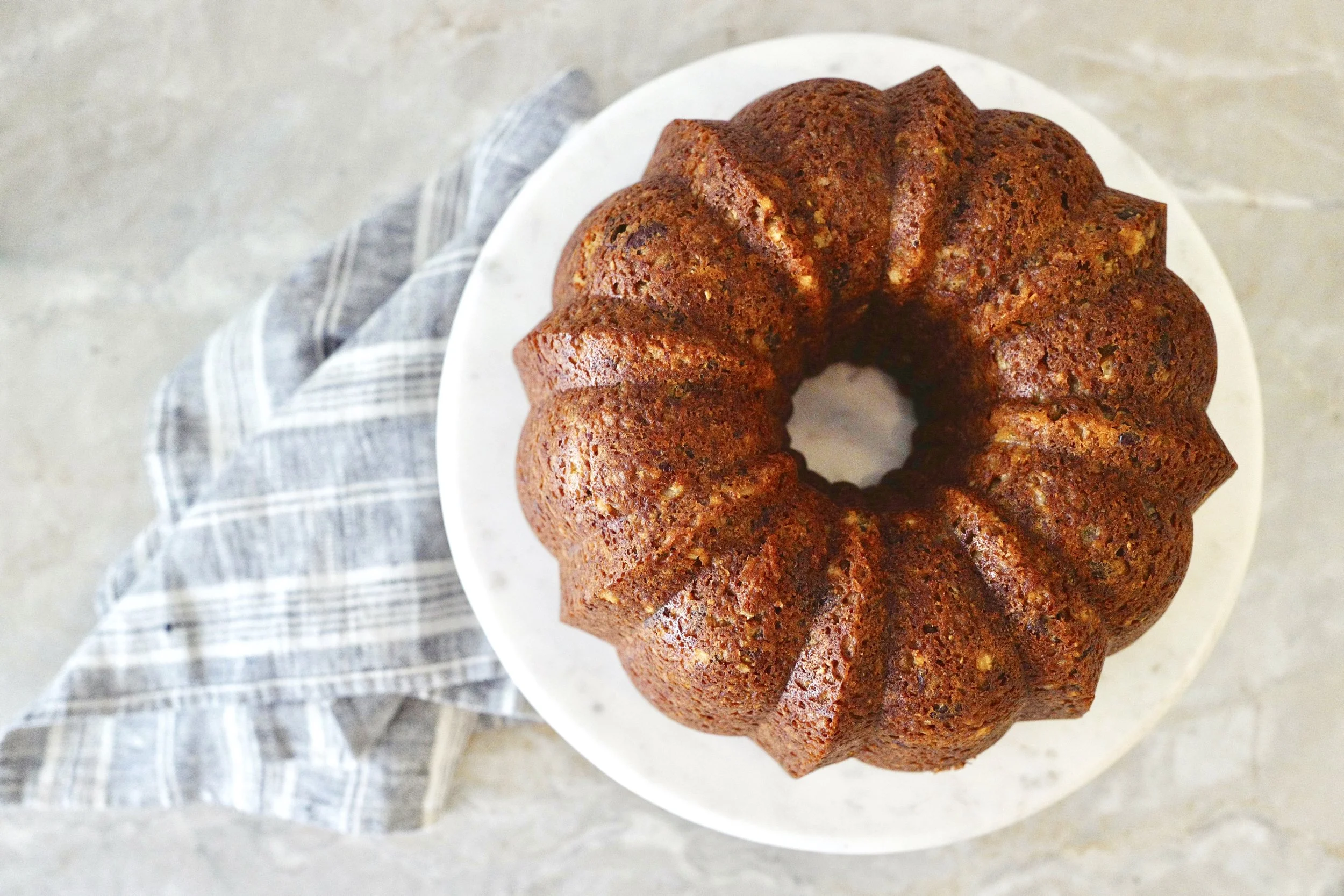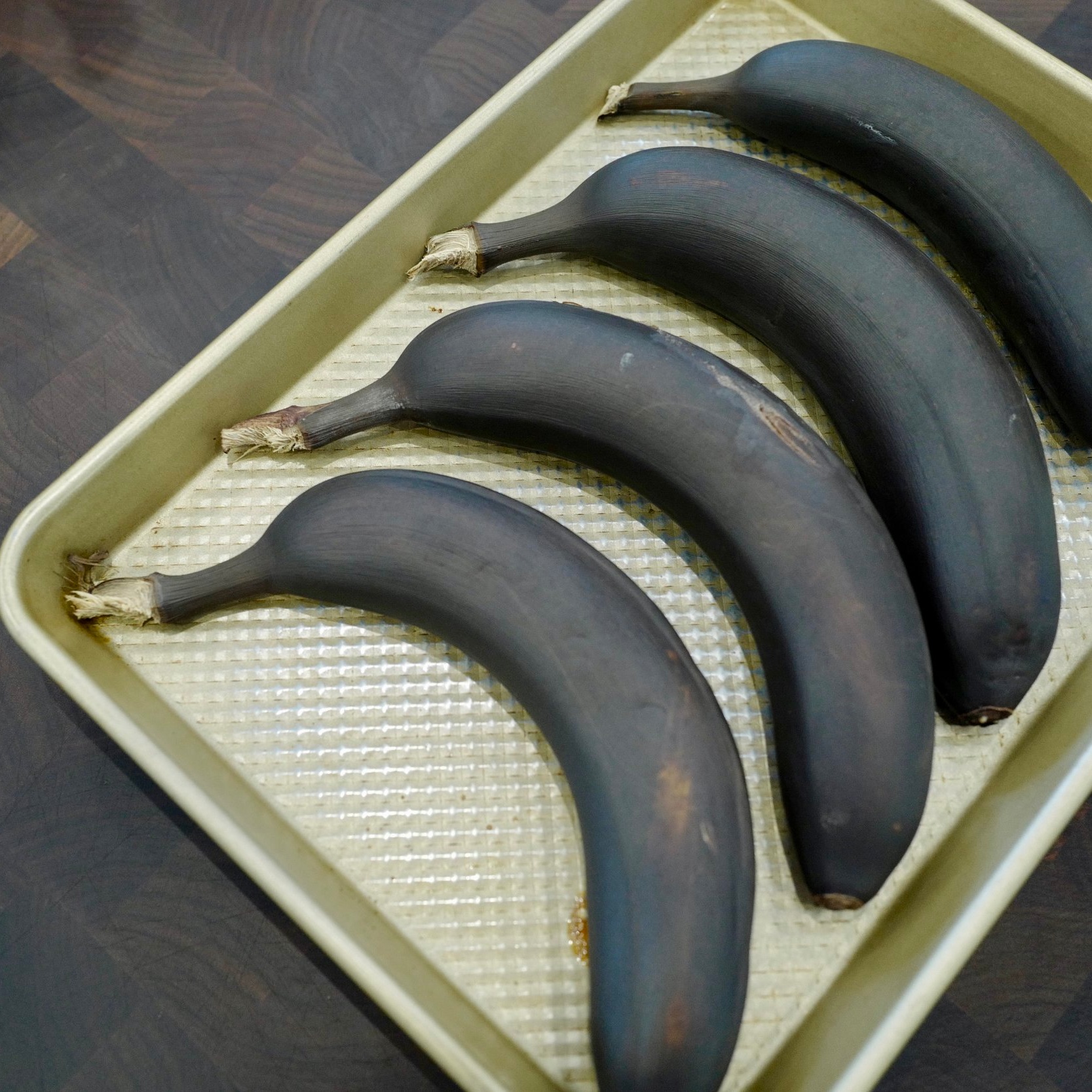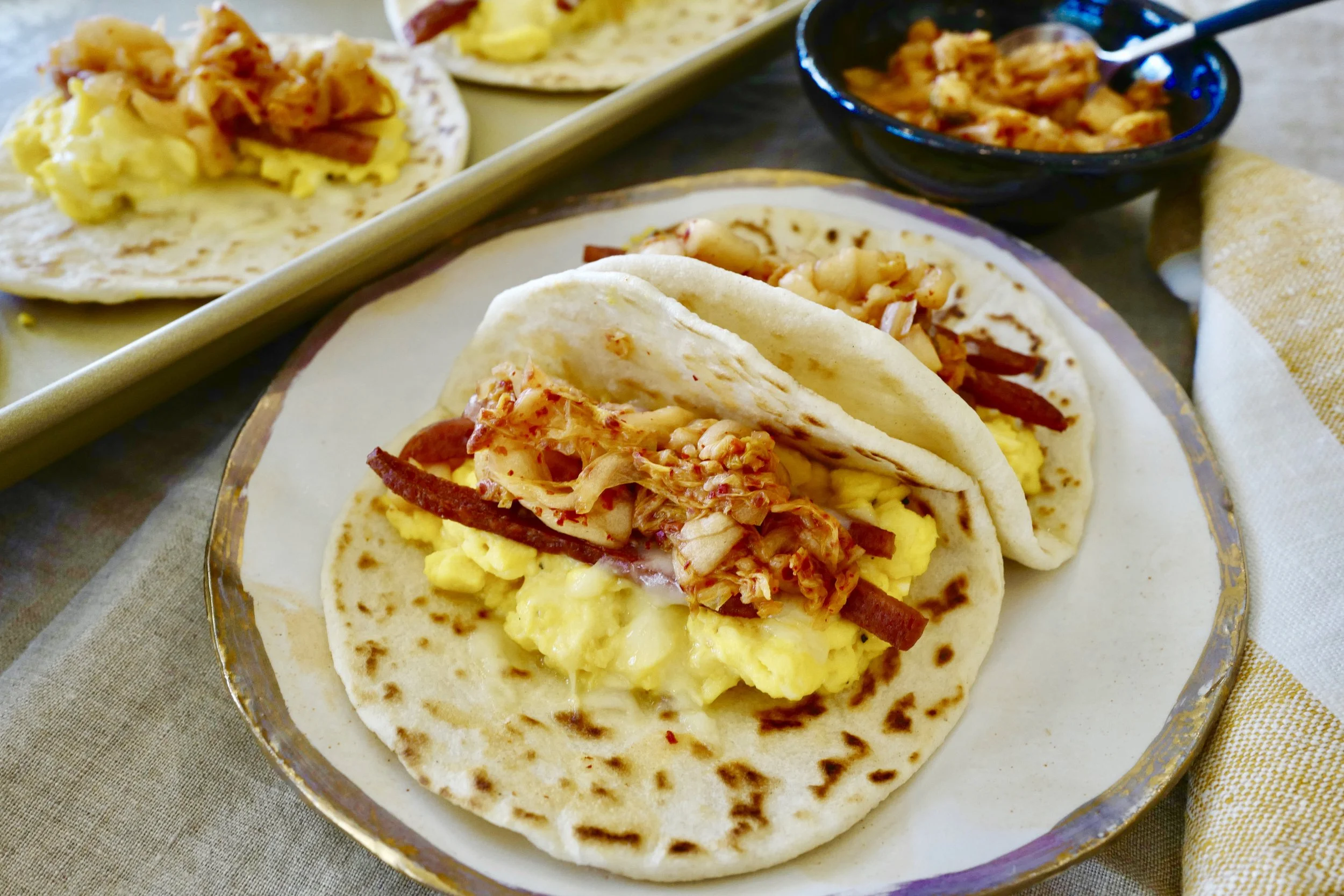Species 002: Roasted Banana, Chocolate, and Coconut Bundt Cake
This is a sneak peek article. For the full suite of recipes, check back here in April.
Banana bread has been a long time favorite of mine, ever since my mom started bringing mini banana muffins in the car for me to scarf down before school or after lacrosse games. I like banana bread any which way—plain or with fixings, cake-like or muffin-like, dense or airy—as long as it’s not over-baked or flavored with banana extract.
One of my favorite banana bread recipes is Tasty Kitchen’s Roasted Brown Butter Banana Bread. It’s simple, down-to-earth, and tastes just about as hearty as banana bread can thanks to the portion of whole wheat flour that adds to the nutty profile of the browned butter and roasted bananas. I don’t mess around with any fixings in this bread because I’m wholly in love with the rich flavor. The cake is best eaten on the ever-so-slightly underdone side, so that the moist crumb can coat your tongue and wrap it in a warm hug. It’s a cake for banana purists—those who can get excited by the idea of a humble roasted banana transformed into a loaf.
Tasty Kitchen’s recipe has been my go to for years, but I recently tried Dorie Greenspan’s Last-of-the-Bunch Banana Bundt. This banana bread, when compared to Tasty Kitchen’s, is a tad more theatrical, with coconut oil, shredded coconut, and semisweet chocolate thrown into the mix. Still, the banana crumb itself is fairly straightforward, dare I say plain. The crumb is sturdy, and the bundt slices like a cake that knows what it’s doing. The flavor of the coconut and chocolate were delightful, but I did miss the depth of flavor and moistness of my usual roasted banana recipe. I loved the playfulness of Dorie’s recipe but wanted to do something to bring these two banana bread versions together. And so, in the spirit of culinary exploration and with these two admirable versions in hand, I set out to create my very own banana bread.
Species 002: Combines the deep flavors of whole wheat flour, browned butter, and roasted bananas with the lively flavors of chocolate and coconut.
Primary Traits
I decided to start with Dorie’s recipe as the basis for my recipe because when it comes to bundts, you can’t really take any quick bread recipe, throw it in the tin, and come out smelling like roses. A recipe like Tasty Kitchen’s, I feared, would come out a dense, stodgy mess. Dorie’s recipe was a balanced bundt recipe, so there I would start.
Don’t feel guilty, sometimes you have to get down to business…
There were two simple goals I wanted to achieve with Dorie’s base recipe:
Increase the moisture level
Deepen the flavor profile of the banana crumb
As is true with most baking, you can’t just swap out one thing willy nilly without affecting something else. A lot of people will, for example, try to cut out half the sugar for health’s sake, and end up with a strangely textured albeit moderately sweet version of the original recipe. Instead of just dumping in more wet ingredients or jacking up the level of spices, I tried to create a set of mutations inspired by the Tasty Kitchen approach, and this is what I came up with.
“...adding whole wheat flour does not make a recipe “healthy”! When I swap whole wheat flour into a recipe, the goal is almost always flavor—sometimes texture.”
Trait #1: Whole Wheat Flour
Flour, I have found, is a sneaky way to add more flavor to all kinds of pastries. Let me dispel one idea, though, before it takes hold: adding whole wheat flour does not make a recipe “healthy”! When I swap whole wheat flour into a recipe, the goal is almost always flavor—sometimes texture. If you’re looking for a healthy banana bread, I would suggest throwing some banana slices on a piece of Ezekiel toast.
The danger in adding whole wheat flour to a recipe is that you will weigh the crumb down, so I always start with a small portion of whole wheat and scale up until I’m happy. Dorie’s recipe calls for a total of 3 cups of all purpose flour, so for my first experiment, I settled on splitting the flour into 1 cup whole wheat flour and 2 cups cake flour to offset the heaviness of the whole wheat. The result was just right in terms of whole wheat flavor, but the cake flour was, in the end, unnecessary. Combined with my whipped cream mutation (Trait #4 below), the banana bread was transformed into a banana cake that was scrumptious but something entirely different—and wanting of some cream cheese frosting. (I’m sure I’ll revisit this tangent again another day… perhaps a Roasted Banana Sheet Cake with Cream Cheese Frosting.) In the end, I backtracked and settled on 1 cup whole wheat and 2 cups all purpose flour.
Trait #2: Browned Butter
I personally have to resist putting browned butter into and onto everything—I’d drizzle it over my dinner plate just to consume more of that liquid gold. It adds a complex nuttiness that complements and highlights notes of brown sugar and caramel.
Dorie’s recipe calls for 8 tablespoons softened butter and 8 tablespoons coconut oil (for flavor), though you can use a whopping 16 tablespoons of butter if you want. The issue with subbing in browned butter for normal butter is that melted butter can greatly affect the texture of your baked good—not always in a catastrophic way, just in a way you should be aware of. The moisture and milk solids separate, making the liquids more available to dissolve any sugar you beat in. On top of that, in the case of browned butter, the solids actually burn slightly, taking away some of the creaminess of the butter. Long story short, you’re changing the very composition of the butter. In order to maintain textural balance while boosting flavor, I settled on a three way split between softened butter, browned butter, and coconut oil.
Trait #3: Roasted Bananas
Banana roasting has a couple of benefits. First, the most practical—you don’t have to wait for your bananas to be completely overripe and spotted. Even a banana with a hint of green around the stem will roast up just fine. I tend to aim for bananas that I’d like to eat: ripe but not yet mushy. The second benefit, and the most important, is that a banana’s flavor is greatly intensified when you roast it. The sugars caramelize, banana-infused moisture is released, and the fruit pulp softens. The result is a more intense banana flavor without having to use any banana extract.
I decided to use roasted bananas in my recipe to complete the triad of complexity: nutty whole wheat flour, aromatic browned butter, and caramelized banana sugars. And by way of fortuitous coincidence, because this triad of flavors had to be used in moderation to maintain the integrity of the crumb, it played nicely with the coconut and chocolate that I loved so much in Dorie’s recipe. The more “theatrical” flairs would stay.
Trait #4: Whipped Cream
The final trick I threw in the mix is the last minute folding of whipped cream into the batter. I can’t take credit for thinking this unexpected trick up—for an in-depth rundown of the kitchen hack, head over to Food52. The gist of it is that you can fold in some plain whipped cream to all kinds of baked goods (mostly batter-based), and you’ll get something simultaneously lighter and richer. I found that 2/3 cup of whipped cream boosted this banana bread’s moisture level without making it stodgy. It also added a rich creaminess to the crumb, without being cloying. Essentially, it lent my recipe some decadence in disguise.
Resulting Species
The resulting banana bread is just the kind I was aiming for. It had the playfulness of Dorie Greenspan’s original bundt with the depth of flavor and moisture of the Tasty Kitchen recipe. The crust has a deep caramel flavor that serves to enhance the flavor of the actual crumb. The coconut and semisweet chocolate dance cordially with the combined flavor profile of the whole wheat flour, browned butter, and roasted bananas, but the total volume and variety of flavor is balanced. The bundt itself is hefty, but trust me, you can easily take down a generous slice or two (or three). Enjoy!
Until next time,
The Culinary Darwinist
This is a sneak peek article. For the full suite of recipes, check back here in April.
Roasted Banana, Coconut, and Chocolate Bundt Cake
Serves 10-12, or 1-2 hungry people for 1-2 days.
Ingredients
Method
Some mise-en-place
- Roast the bananas: Preheat the oven to 375ºF. Place the bananas, unpeeled, on a sheet pan and roast for 20 minutes—until the skin is a dark brown and juices are bubbling out. While the bananas are still hot, use two forks to split the skin and scrape the fruit out. It's best to do this straight on the sheet pan so you keep any juices that leaked out. Discard the skins. Mash the bananas and set aside to cool completely.
- Brown the butter: In a small saucepan on medium-low heat, melt 5 tablespoons of the butter. Once melted, the butter will start to foam— stay calm and don't walk away. Once the foam dissipates, you'll start to see golden-brown flecks at the bottom of the pan and smell a nutty aroma. Swirl the butter to avoid burning. Pour into a small bowl to cool completely.
- Whip the cream: Using a hand mixer with the whisk attachment (or just your hands), whip the heavy cream until it holds stiff peaks. Set aside in the fridge. Don't underwhip the cream, or it will just dissipate into your batter without doing much lightening up.
- Decrease the oven temp to 350º and grease a bundt pan. I won't lie, I use Pam for a job like this.
Make the cake
- In a medium bowl, sift together the whole wheat flour, AP flour, and ground nutmeg. If I'm honest though, I only sift things together if I see stubborn lumps in the flour—and I'm still alive.
- In a stand mixer with the paddle attachment, beat together the softened butter, cooled browned butter, and coconut oil until well combined and fluffy (1 min, high speed). Add in the sugar, brown sugar, and salt and beat until fluffy again (2-3 min, high speed). Don't go skimping on this! It's important that the mixture is fluffy to achieve a light crumb.
- Beat in the eggs, one at a time, and vanilla, making sure you get to the fluffy point after each addition (1 min after each egg, high speed). Beat in the roasted banana mix. Don't panic—the mix will look gross and curdled at this point.
- Add half of the flour mixture to the bowl and mix until almost combined (20 sec, low speed). Add all of the yogurt and mix until almost combined (20 sec, low speed). Add the rest of the flour mixture and, you guessed it, mix until almost combined (20 sec, low speed). Add the chocolate and coconut, and mix until actually combined (30 sec, low speed).
- Remove the bowl from the mixer and, using a spatula, fold the whipped cream into the batter. Be sure to scrape all the way down to the bottom of the bowl. Stay calm and keep folding until just incorporated. As long as you don't beat the crap out of it, your mix will be fine.
- Pour the batter into the greased bundt pan, smoothing the top and tapping the pan on the counter to release any air bubbles. Bake at 350º for 50-60 minutes. The cake shouldn't jiggle when you shake it, but a toothpick should come out glistening—not completely dry. Let the cake cool for 10 minutes in the pan, then turn out onto a wire rack to cool completely. ∎
This is a sneak peek article.
For the full suite of recipes, check back here in April.














